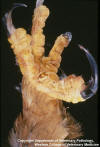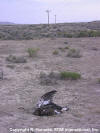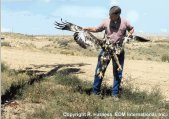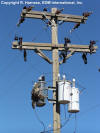|
|
| |
| Risk Factor |
-
Injuries or death resulting from the passage of electric current through
the body.
-
More common in birds, but also in species of climbing mammals.
|
| Images |
|
Click on
images to enlarge. |
 |
 |
 |
 |
|
Burns are usually visible on
the soles of the foot of an electrocuted bird. Burns may vary
from subtle red areas to burns where the skin is severely
damaged. |
Electrocuted raptors are often found dead underneath electrical
transmission wires. |
Charred feathers or fur are
characteristic of electrocuted animals. |
The greatest hazards for
electrocution occur at poles with transformers or grounded metal
equipment near the conductors. |
|
| Distribution |
|
Geographic: |
-
The potential for electrocution exists wherever high-voltage wires are
present.
|
|
Seasonality: |
|
|
|
| Mechanism of Action |
-
If an animal’s
appendages bridge the gap between two energized components
or between an energized component and grounded
component, electrical current flows through the gap created
by the animal’s body.
-
Electrical current passing through the body can
cause irritation, unconsciousness, burns or immediate death
depending on the strength (amperage) of the current, the
degree of grounding or earth contact of the animal, duration
of the shock, degree of moisture present on the points of
contact, and, in the case of birds, whether bare skin,
feathers or fur are in contact with conducting wires, the latter
being a relatively poor conductor.
|
|
| Signs and Symptoms |
-
Animals injured or killed by electrical accidents are often found near
power poles or below power lines.
-
Erratic heart rhythm and
paralysis in areas of the brain that
control breathing and heart rate are usually the cause of death in
fatal cases.
-
Burning or charring of hair,
feathers or skin is often apparent, usually at the point of contact
between the animal and the energized or grounded component.
-
Distribution of
lesions depends on the areas
affected (e.g., where the current entered or left the body).
-
If an animal initially
survives electrical injury, they are often prone to secondary
bacterial infections at the site of
electrical contact, usually a limb; the function of the infected
area may be compromised.
|
| Meat Edible? |
-
Barring the presence of other diseases, meat taken from an electrocuted
animal may be consumed.
|
| Risk Reduction |
-
Companies supplying electricity are continually working to reduce
wildlife mortality and power outages caused by interactions between
wildlife and power transmission lines.
|
| Samples for Diagnosis |
-
In general, a whole carcass is needed to determine if electrocution was a
cause of death.
|
| Similar Diseases |
-
A dead animal found
beside or near power poles or power lines cannot immediately be
assumed to have been electrocuted; birds often collide with power lines without
electrical injury and are often found underneath. See also
trauma.
|
| Further Reading |
-
Cooper J.E. 1996. Physical injury. Pp. 157-172 in A. Fairbrother, L.N.
Locke, G.L. Hoff (eds.),
Non-infectious Diseases of Wildlife. Iowa State University
Press. Ames, IA. 219 pp.
-
Thomas N.J. 2001. Electrocution. Pp. 357-360
in
Field Manual of
Wildlife Diseases: General Field Procedures and Diseases of Birds.
M. Friend, J.C. Franson (Tech. eds.), E.A. Ciganovich (ed.).
Biological Resources Division Information and Technology Report 1999-001. U.S. Department of the Interior and U.S.
Geological Survey. Washington, DC. (PDF
of Chapter)
|
|
|



